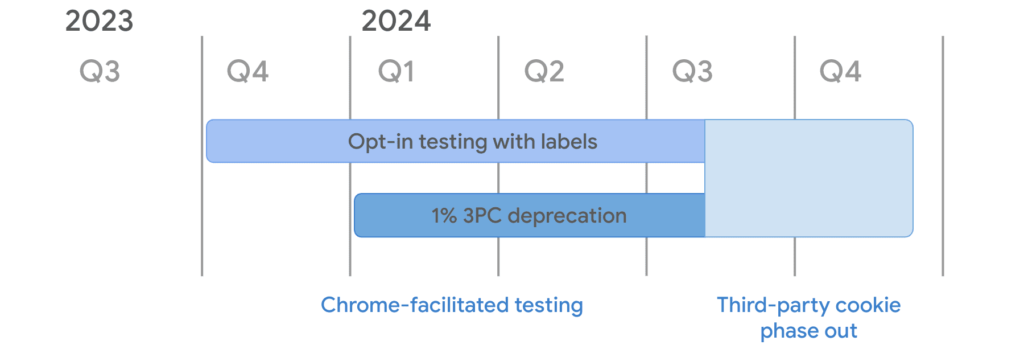Late in February, we told you about Google’s promise to dole out punishment to spammy sites. During, March 2024, Google’s updates to its spam policies has certainly done that. The update has affected all the websites that manipulate search rankings through automated or AI-generated content. This change was a response to recent incidents where large publishers have been caught using AI-generated articles on their websites without proper oversight. The updated policy, which will continue through May 2024, explicitly targets “scaled content abuse,” a term used to describe the creation of large amounts of low-quality, unoriginal content designed solely for ranking manipulation.
This update also expanded the definition of scaled content abuse beyond text-based content, potentially impacting other formats like images and videos. These changes aim to improve the quality of search results and penalize those who engage in manipulative tactics.
As we have been watching the havoc caused by this core update This article, there is definitely a lot more information to delve into, and the details of the updates and what they mean for website owners and SEO professionals. We will also discuss a real-life example of scaled content abuse and its consequences. This information can help businesses stay ahead of Google’s guidelines and continue to provide valuable content for their users.
Why this update is significant
The updated spam policy spotlights the issue of scaled content abuse, which has been a growing concern for Google and its users. It also shows that Google is proactively addressing manipulative SEO tactics and ensuring that only high-quality, relevant content ranks well in search results.
This update also highlights the importance of regularly auditing website content and ensuring it adds value to users. Website owners and SEO professionals must be aware of the potential consequences of using automated or AI-generated content in large quantities, as it can now result in penalties from Google.
Furthermore, this update reinforces the importance of creating original, high-quality content to rank well in search results. The focus on providing value for users aligns with Google’s overall mission of improving the search experience for its users.

What’s Changed In The Spam Policies?
Google’s recent spam policy updates mark a significant evolution in how the search engine giant addresses manipulative tactics and low-value content on the internet. Let’s delve into the fundamental changes and their implications for SEO strategies.
Expired Domain Abuse: A New Focus
Google’s inclusion of “expired domain abuse” as a spam policy target signifies a crackdown on domain squatting strategies. This tactic involves purchasing expired domains to manipulate search rankings by hosting content that offers little value to users. The search engine giant’s heightened attention to this practice suggests a recognition of its potential impact on search result relevance and user experience.
Plus, this change also highlights the importance of conducting thorough research before purchasing a domain and avoiding any that may have been previously used for spammy purposes.
Implications of Expired Domain Abuse
Adding expired domain abuse to Google’s spam policies reflects a deeper understanding of how some individuals exploit expired domains for SEO gains. By redirecting pages from expired domains to relevant pages on active sites, they attempt to leverage the authority built by these domains. While not inherently wrong if used ethically, this tactic can lead to manipulative practices aimed at artificially boosting site authority and search rankings.
Additionally, this update also reinforces the importance of regularly monitoring website backlinks and disavowing any from expired domains or spammy sites.
Real-World Examples of Expired Domain Abuse
The case of The Hairpin serves as a real-world example of expired domain abuse. After the original site ceased publication, the domain was purchased and repurposed as an AI-generated content farm. This blatant attempt to capitalize on the domain’s authority highlights the need for Google’s measures to combat such practices and maintain search result integrity.
As seen in this example, the consequences of expired domain abuse can lead to a severe drop in search rankings and traffic, ultimately impacting a site’s overall online presence. Therefore, it is crucial to stay informed about Google’s spam policies and avoid manipulative tactics that could result in penalties.
Site Reputation Abuse: Targeting Parasite SEO
Google’s introduction of “site reputation abuse” targets practices often associated with Parasite SEO (pSEO). This tactic involves publishing third-party pages on established domains with minimal oversight, aiming to manipulate search rankings using the host site’s reputation signals. The policy update underscores Google’s efforts to discourage manipulative strategies that exploit reputable domains for ranking benefits.
As with expired domain abuse, the inclusion of site reputation abuse in Google’s spam policies emphasizes the importance of conducting thorough research and avoiding unethical practices that could harm a website’s online presence.
Addressing Manipulative Content Strategies
Including site reputation abuse in Google’s spam policies emphasizes the importance of editorial oversight and content relevance on established websites. By penalizing strategies that involve hosting third-party content without substantial involvement or oversight, Google aims to maintain the integrity of search results and prevent manipulative SEO tactics.
Examples of Site Reputation Abuse
Google’s examples, such as third-party pages on sports sites with minimal editorial involvement, highlight instances where the primary purpose is to manipulate search rankings rather than provide valuable content to users. This policy update warns website owners and SEO practitioners to engage in practices that compromise search result quality and user trust.
Scaled Content Abuse: Broadening the Scope
The rebranding of “spammy automatically generated content” to “scaled content abuse” represents a broader approach to tackling low-value content across various formats. This update expands the definition to encompass content generated at scale without adding substantial value, regardless of the method used. Google’s focus on content quality and user relevance underscores its commitment to delivering meaningful search experiences.
Diverse Examples of Scaled Content Abuse
Google’s examples of scaled content abuse, including generative AI tools, content scraping, and nonsensical content creation, demonstrate the diverse tactics used to manipulate search rankings. By targeting these practices, Google aims to discourage the proliferation of low-quality content that detracts from the user’s search experience and overall satisfaction.
Impact on SEO Strategies
Google’s spam policy updates highlight the continued importance of providing valuable and relevant content for users. These changes also emphasize the need for ethical and transparent practices in SEO strategies, as any attempts to manipulate search rankings can result in penalties and harm a website’s online presence.
Also, website owners and SEO practitioners should regularly review Google’s policies to stay informed of any changes that could impact their strategies. By focusing on content quality and user experience, websites can build trust with users and search engines, leading to long-term success in the competitive online landscape.
FAQs
How does the March 2024 core update address manipulating search rankings through link spam?
The March 2024 core update has introduced enhanced search engine algorithms designed to identify and penalize link spam more effectively. This update aims to preserve the integrity of search results by diminishing the impact of artificial links intended to manipulate search rankings. Site owners are encouraged to build natural, high-quality backlinks for their SEO strategy.
What is Google’s stance on creating multiple sites to manipulate search engine rankings?
With the latest spam update, Google has reinforced its guidelines against creating multiple websites that serve the same content or are intended solely to cross-link with each other to manipulate search rankings. This practice, often seen in attempts to dominate search results for specific keywords, is now more likely to be detected and penalized. Site owners should invest time enhancing a single site rather than spreading resources across multiple low-quality sites.
Can you explain how the new policy combats expired domain abuse for SEO purposes?
The new Google spam policy is more assertive against the abuse of expired domains. Some SEO practitioners purchase expired domains with high authority to create or redirect to their sites, attempting to inherit the domain’s ranking power. The March 2024 update improves the detection of such practices, ensuring that the use of expired domains does not unfairly influence search rankings. This aims to maintain a level playing field for all site owners.
How does the update affect sports site hosting and other niche websites that are not very big?
The recent spam update is designed to be equitable across all websites, regardless of their size or niche, including sports site hosting. The primary focus is on the quality of content and the authenticity of SEO practices rather than the site’s scale. Smaller or niche sites that adhere to Google’s guidelines and focus on creating valuable, original content for their audience can still compete effectively in search rankings. The update encourages all site owners to concentrate on legitimate SEO practices to improve their visibility in search results.
Conclusion
Google’s recent spam policy updates reflect its continued efforts to maintain the integrity of search results and deliver valuable experiences for users. By targeting manipulative practices such as expired domain abuse, Google site reputation abuse, and scaled content abuse, Google aims to promote ethical and transparent SEO strategies that prioritize user relevance and satisfaction.
Website owners and SEO practitioners must stay informed about these changes to ensure their strategies align with Google’s policies and maintain their online presence. Ultimately, focusing on creating high-quality content that adds value to users will lead to long-term success in the ever-evolving world of SEO.
So, staying updated with search engine policies is essential for a sustainable online presence. And remember, ethical and transparent practices are vital to achieving long-term success in SEO.









